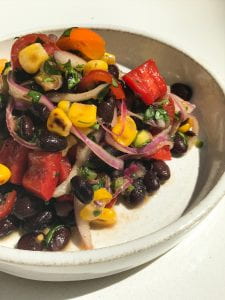Spilling the Beans: to salt or not to salt?
 When it comes to cooking beans, the subject of salt has long been contentious. Traditionally, the belief has been you should not add salt to the beans until after they are cooked or else they’ll have an unpleasant, grainy texture. Many culinary experts still opt to use salt, but disagree on when it should be added or in what amount.
When it comes to cooking beans, the subject of salt has long been contentious. Traditionally, the belief has been you should not add salt to the beans until after they are cooked or else they’ll have an unpleasant, grainy texture. Many culinary experts still opt to use salt, but disagree on when it should be added or in what amount.
Properly cooked beans have a slightly firm bite and a smooth, creamy texture that is not watery or gritty. They should appear shiny with bright colour and not be broken when cooked. The flavour should be earthy and not salty.
The Culinary Research team at Red River College used a combination of scientific process and culinary knowledge to test various combinations in search of the perfect bean. This article highlights their findings regarding how salt addition and water hardness affect the cook times, flavour, texture and appearance of five bean types.
COOKING WITH SALT
SOAKING BEANS IN SALT BRINE
When cooking beans from dry, salt can be added to the soak water to improve the quality and cooking time. Following cooking trials, it was found that beans soaked in a 2% salt brine* had reduced cooking time, as well as improved cooked flavour and texture compared to soaking in distilled water.
*Prepare 2% salt brine by adding 2.5 teaspoons (15g) of salt to 3 cups of water, stir until fully dissolved.
COOKING BEANS IN SALTED WATER
In cooking trials, the researchers added 0, 1, 2 and 3% quantities of salt to cooking water after a 24-hour soaking period at room temperature. They found that beans cooked in 1-2% salted water had reduced cooking times, compared to unsalted water*.
*Prepare 1% salted cooking water by adding 1.5-2 teaspoons (10 g) to 4 cups of fresh, distilled boiling water.
Prepare 2% salted cooking water by adding 3.5 teaspoons salt (20 g) to 4 cups of fresh, distilled boiling water.
IMPORTANT NOTE ON HARD WATER
Hard water is found throughout Manitoba. It is important to note that hard water can greatly affect final sensory characteristics and cooking time of beans.
Researchers completed bean cooking trials at Red River College using soft water (30mg CaCO3/L) and hard water (120 mg CaCO3/L), as well as with distilled water (0mg CaCO3/L) for kidney beans and black beans. When hard and soft water are used for soaking and cooking beans, the cooking time is increased and the cooked quality is decreased. This effect is most prominent in larger kidney beans where the cook time is increased by 17% and 70% for soft water and hard water respectively. Although the best results came from beans cooked in distilled water, this may not be practical for everyday cooking. Further research is required to refine methods for cooking beans using hard tap water.
RECOMMENDED SALTING METHODS FOR DIFFERENT BEAN TYPES
Trials were conducted on five bean types: kidney, black, faba, navy and pinto. The use of 1-2% salt reduced cooking time* and improved the flavour, texture and appearance of cooked beans.
Based on the study, the cooking recommendations for each bean are as follows:
Navy Bean: 2% brine soak (average cook time = 34 min)
Black Bean: 2% brine soak (average cook time= 28 min)
Faba Bean: 1% salt in cooking water (average cook time = 9 min)
Kidney Bean: 1% salt in cooking water (average cook time = 36 min)
Pinto Bean: 1% salt in cooking water (average cook time = 26 min)
*Cooking time for beans begins when the cooking water reaches a gentle simmer. Water should be kept from vigorously boiling to prevent beans from bursting open.
Researchers concluded a little salt goes a long way in improving the overall flavour of beans.
Ready to start cooking with beans? Check out this tasty recipe:
 Southwest Bean Salad
Southwest Bean Salad
- 1 1/2 Cup Black Beans, cooked
- 1 Cup Cherry Tomatoes, quartered
- 1/2 Cup cilantro, chopped
- 1/3 Cup Red Onion, slivered
- 1/2 of one jalapeño, seeded, minced
- 1 Cup Corn, toasted
- 1 Cup, Bell Pepper, diced
Southwest Lime Dressing
- 1/3 Cup Lime Juice, fresh
- 1/4 Cup Canola Oil
- 2 Tbsp Honey
- 1 tsp Cumin, dry ground
- 1/2 tsp Salt
In a large mixing bowl, all add ingredients for Bean Salad, set aside. In a medium sized mixing bowl, whisk together ingredients for dressing. Adjust seasoning as desired. Pour dressing over salad, and stir until well coated. Serve immediately, or refrigerate for a few hours, stir again and serve.
Optional additions:
Avocado, chickpeas, cucumber, Cotija Cheese, Quinoa, Grilled Chicken, etc.
Funding for this work was provided by the Manitoba Pulse and Soybean Growers. Special thanks to Culinary co-op student Aileen Lopez and the Canadian International Grains Institute. Members of the industry advisory group, Tanya Der (Pulse Canada) and Dr. Ning Wang (Canadian Grain Commission) are gratefully acknowledged.
